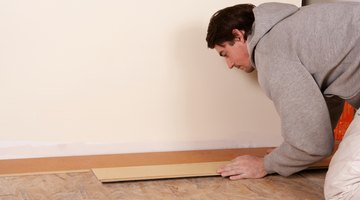How to Install the Transition Strips for Wood Laminate Flooring
A laminate flooring transition strip is designed to provide a smooth transition between two flooring types such laminate and tile, or laminate and carpeting. The transition strip covers the ends of both floor types at the same time, primarily in entryways.

A metal rail screwed down between the types of flooring holds the strip in place. Transition strips are not hard to install, and can be used on wood or concrete subfloors.
-
Measure the width of the entryway for the transition strip, using the tape measure, and mark the same measurement on the metal rail with a pencil. Use the hacksaw to cut the metal rail to length.
-
Set the metal rail evenly spaced between the two types of floor with the rails facing up, and the screw holes touching the subfloor. Use the pencil to color in the screw hole locations on the subfloor, and remove the rail from between the floors.
-
Insert the appropriate size and type of drill bit into the variable-speed drill, or the hammer drill. Use the variable-speed drill and wood drill bit for a wood subfloor, and the hammer drill with a masonry drill bit for a concrete subfloor.
-
Drill each screw hole location marked on the floor. Each screw hole only has to be deep enough to accommodate an anchor. Look at the anchors to judge the depth of the holes. The anchors are plastic, and are packaged with the screws that came with the transition strip.
-
Press an anchor into each screw hole and set the metal rail over the anchors. Line up the holes in the metal rail with the anchors in the floor. Insert a screw through each hole in the metal rail and into the anchors. Tighten the screws with the variable-speed drill and Phillips-head drill bit.
-
Measure the entryway from jamb to jamb with the measuring tape, and mark the same measurement onto the transition strip with the pencil. The measurement will be the same length as the metal rail, but it is always better to measure twice, and cut once.
-
Cut the transition strip to fit in the entryway, using the fine-toothed hand saw. Cut the end cap for a laminate-to-carpet transition, or cut the reducer for a laminate to vinyl transition the same length as the transition strip. The end cap is a long, square shape that snaps onto the short ridge on the back of the transition strip. The end cap rests on the carpet to keep the edge of the carpet in place. The reducer is a thin, angled strip that provides a smooth, angled step from vinyl to the laminate.
-
Place the transition strip in the entryway. Align the ridge in the center of the transition strip with the metal rail and press down on the transition strip to secure it in place.
Things You Will Need
- Tape measure
- Pencil
- Hacksaw
- Variable-speed drill
- Wood drill bit
- Hammer drill
- Masonry drill bit
- Phillips drill bit
- Fine-toothed hand saw
Tip
Use a rubber mallet to assist you with snapping the transition strips into the rails. If the strip will not go in, check to make sure that you have the ridge lined up between the side rails. Use the mallet lightly.
Warning
Take your time when measuring and cutting the transition strips. Once you cut it, you can't take it back.
Writer Bio
Based in Oklahoma City, Debbie Tolle has been working in the home-improvement industry since 2001 and writing since 1998. Tolle holds a Master of Science in psychology from Eastern Illinois University and is also a Cisco-certified network associate (CCNA) and a Microsoft-certified systems engineer (MCSE).
Photo Credits
- Jupiterimages/Photos.com/Getty Images
- Jupiterimages/Photos.com/Getty Images
More Articles
- Installing Hardwood Floors in a Mobile Home
- How to Replace Wood Porch Railings With Vinyl Railings
- How to Install Laminate Floor Covering on Curved Surfaces With Transitions
- How to Raise a Sunken Living Room
- How to Install Indoor-Outdoor Carpet With Glue
- How to Fix Wood Floors That Look Dull After Steam Cleaning



